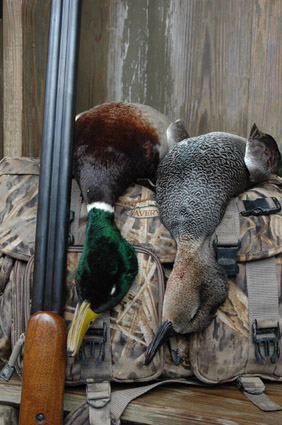 Things are different in today’s waterfowling world. Thirty years ago, the pass-shooter was looked upon as a long-range specialist who, in addition to knowing his firearm and shotshell of choice intimately, had an in-depth working knowledge of waterfowl and their habits. This man could not only recognize a flight line or path, but could tell why that particular flight line existed. He knew the best days — weather-wise — to be in the field, and in many cases, could estimate the distance from a point on Mother Earth to a point somewhere in space to within a couple feet — not yards.
Things are different in today’s waterfowling world. Thirty years ago, the pass-shooter was looked upon as a long-range specialist who, in addition to knowing his firearm and shotshell of choice intimately, had an in-depth working knowledge of waterfowl and their habits. This man could not only recognize a flight line or path, but could tell why that particular flight line existed. He knew the best days — weather-wise — to be in the field, and in many cases, could estimate the distance from a point on Mother Earth to a point somewhere in space to within a couple feet — not yards.
Today, however, just saying the word pass-shooter can get you into trouble in some places. In many locales, the phrases pass-shooter and sky-buster — Translation: A “hunter” unable to estimate distance and prone to shooting at ridiculous ranges — are used interchangeably. Pass-shooters, some say, are simply lazy, not wanting to go to the effort of scouting, putting out a decoy spread, nor learning the nuances of duck vernacular. But are these criticisms deserved, or is the modern pass-shooter getting a bum rap?
First, let’s take a look at a general definition of pass-shooting. Pass-shooting, to most waterfowlers, entails placing yourself in a location so as to be within effective shotgun range of ducks and/or geese trading back and forth between Point A and Point B. Unlike hunting over decoys, pass-shooting doesn’t rely on outside stimuli, e.g. decoys, to attract birds to a certain spot on the map, but rather takes advantage of an already-existing air highway or flight path.
There are three primary elements to successful pass-shooting — locating a suitable flight line, weather and blinds. It’s one thing to find a path that the birds are using regularly between Points A and B; it’s another altogether to find one that places you within effective shotgun range of those birds. That said, it’s vital to look for and recognize key areas — higher elevations such as a hump in a field, or a bluff or river break that the birds must climb over as they leave a roosting area. A break in a treeline, too, will often serve as a gate from a mid-morning loafing pond to a feeding area. Scouting, or time spent afield with maps and binoculars, is the best way to determine these prime locations.
Weather can play a major role in successful pass-shooting. Often, high clear skies mean birds will fly higher. Factors such as low skies or clouds, light rains, snow, or best of all, high winds have a tendency to push birds down onto the deck, as the pass-shooters say; that is, down to altitudes suitable for shotgunning purposes. It’s not always the case, but I’ll certainly take a windy day over a calm, bluebird day any time.
As for blinds and pass-shooting, one word applies — mobility. Unless the flight line situation you’ve discovered is and stays perfect throughout the season (some are and do), it’s best that you and your blind be mobile so as to move back and forth as the birds do. Several portable blinds can be found in the latest Mack’s Prairie Wings catalog, any one of which will work just fine in a pass-shooting situation; however, nine times out of 10, Mother Nature will provide all the blind that’s necessary in the form of cattails, bushes, hedges, tall grass or any of a 1,000 other natural hides.
And finally, shotguns and ammunition. Traditionally, pass-shooting was thought to be synonymous with long-range (50+ yards) shooting; however, that’s not always the case. The best advice in this regard is to scout your location thoroughly. Spend a few mornings or evenings in the field determining not only the flight path, but the distances involved as well. Chances are a 3- or 3½-inch 12-gauge will be employed, with shot sizes and materials ranging from steel BBs and #1 to something such as Hevi-Shot in #2 and #4.






